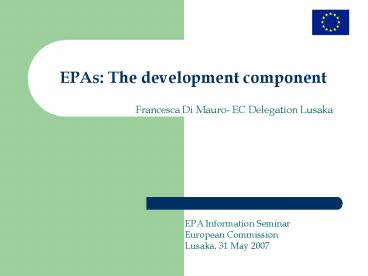EPAs: The development component - PowerPoint PPT Presentation
1 / 13
Title:
EPAs: The development component
Description:
ESA region mostly made up pf LDCs (out of 15 countries only 4 are non-LDCs) ... mio euro): capacity building to RIOs for negotiations and trade-related capacity ... – PowerPoint PPT presentation
Number of Views:33
Avg rating:3.0/5.0
Title: EPAs: The development component
1
EPAs The development component
- Francesca Di Mauro- EC Delegation Lusaka
EPA Information Seminar European
Commission Lusaka, 31 May 2007
2
I. The ESA case for requesting more aid
- ESA region mostly made up pf LDCs (out of 15
countries only 4 are non-LDCs) - ? In general, these are countries in need, for
which trade can be a necessary but not a
sufficient factor for poverty reduction - Reciprocity of trade liberalisation in EU-ESA may
bring costs - Revenue losses costs
- Adjustment costs for labour (across sectors),
for enhancing production capacity (including via
better infrastructure), for facing competition - ? Dynamic factors should be taken into account
increase in trade volumes, graduation - Implementation costs may also arise (legal,
administrative)
3
I. The ESA case cont.d
- Since the start of text-based negotiations
(September 2006, Mombasa) ESA request for
additional funding has been a sticky point - Turning point February 2007 (Brussels) Joint
EC-Ministerial Declaration - Commitment to end of 2007 deadline
- Acknowledgement of need to mobilise additional
resources, beyond EDF EU member States and other
donors (Aid for Trade) - Use agreed Development Matrix as a basis for
assessing needs - Recognition of importance of regionally-owned
mechanisms, such as the COMESA Fund, to pursue
improved aid effectiveness
4
II. The development component
- A comprehensive strategy for addressing the
regions concerns on facilitating the flow of
development assistance - Work on EPA text
- Work on the Development Matrix
- Implement the Aid for Trade initiative
- Make best use of existing and future EDF
resources
5
1. EPA text and the Development chapter
- Based on February Declaration, revision of
ESA-EPA text (Lilongwe, April 2007) - Inclusion of a Development Clause in text,
fully in line with February Declaration - Identification of objectives, areas of
cooperation and specific actions for each sector
where development cooperation is expected - Reference in the text to the Development Matrix
6
2. The Development Matrix
- First draft of the matrix large list of projects
totalling 15 billion in infrastructure only! - Credibility issue, prioritisation is key
- Work in progress, being revised, discussions
on-going on the nature of the Development Matrix
dynamic and evolving
7
3. Aid for trade
- Global commitments made back in 2005 by G8, EU
- - EU MS committed 1 billion by 2010 EU Council
reconfirmed on 16/10 this commitment, and called
for a monitoring system to be put in place? new
Aid for Trade Communication - - other G8 members also committed large
increases in Aid for Trade
8
3. Aid for trade, cont.d
- EC Aid for Trade Communication (April 2007)
- Starting point for a comprehensive EU strategy to
be agreed in the second half of the year - Reiteration of Aid for Trade commitments
increase EU Trade-related assistance up to 2
billion euro a year by 2010 (equally split
EC/EU), supporting - Trade policy and regulation (institutional
capacity) - Trade development (business capacity)
- Mostly ACPs and EPAs
- More broadly trade-related infrastructure,
productive capacity and trade-related adjustments - Efforts towards enhancing quality of EU Aid for
Trade aid effectiveness agenda, use of
regionally-owned mechanisms - Effective monitoring and reporting, identifying
result-based indicators to measure the impact of
Aid for Trade on poverty reduction
9
4. Effective use of EDF resources
- On going programmes 9th EDF (2000-2007)
- RSP 287 million (RIP 2003-2007) for ESA, of
which - RISP (30 mio euro) capacity building to RIOs for
negotiations and trade-related capacity - RTCS/PIP identification of infrastructure needs
- RISM (78 mio euro) forthcoming programme to
address issue of revenue losses deriving from
trade liberalisation
10
4. Effective use of EDF resources, cont.d
- Future programmes under 10th EDF (2008-2013)
- ESA Regional programme (RSP) 465 million
focal areas include - 1) Regional Economic Integration and
Infrastructure (325 million) supply-side
constraints (infrastructure, PSD), adjustment
costs, capacity building - 2) Management of Natural Resources, Environment
and Food Security (80 million) - 3) other programmes (40 million) peace and
security, capacity building - increase use of regionally-owned funding
mechanisms
11
4. Effective use of EDF resources, cont.d
- National programmes ESA 15 members would
receive around 3.6 billion within their CSPs
focal areas often include support to regional
integration, private sector development,
infrastructure, and capacity building - Total envelope could be up to 5 billion for ESA
12
Conclusions
- ESA region mostly made up of LDCs, needs are
large, but cannot all be attributed to EPA - Trade is only one of the determinants of poverty
reduction - To address concerns on potential costs, EPAs are
accompanied by a substantial funding package,
with increased amounts available from EDF
(approx. EUR 5 billion in total for the ESA
region) EU MS commitments should also be added,
and those of other G8 countries - Prioritisation in use of funds will be key, as
well use of regionally-owned funding mechanisms
13
THANK YOU!
- For any queries
- Francesca.di-mauro_at_ec.europa.eu































